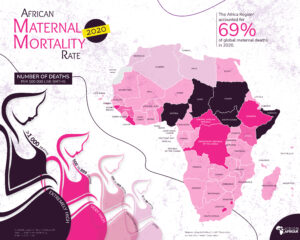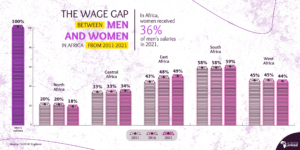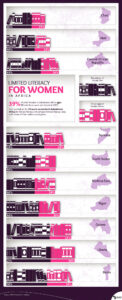Data is an essential tool for tackling pressing political, economic and social issues on our continent. Without reliable data, not only are interventions ineffective, but they can also be harmful. Making decisions based on assumptions rather than solid information about the problems is not just impractical—it’s unethical. So, we must acknowledge those doing their best with the information available, even when it’s not the best. Despite the challenges, their efforts are commendable and highlight the urgent need for better data.
In addressing various issues African women and girls grapple with, gendered data is important. We know that in Africa, like in most of the world, women and girls are far from enjoying the same rights, resources, opportunities and protections as men and boys because of gendered inequalities that are historically rooted in colonial legacies and patriarchal systems.
Data plays a fundamental role in mobilizing and monitoring to achieve gender equality as it helps identify gaps, streamline policies, and direct resources. However, gender statistics remain underfunded, and disaggregated data is inaccessible.
One of the biggest challenges we face is finding updated and reliable data sources across Africa. From discrimination and legal barriers, violence against women, harmful practices, women in leadership positions, care work, sexual and reproductive health and rights, financial inclusion and access to economic resources, access and use of technology, etc, better and reliable data is needed to inform meaningful responses for millions of women and girls.
Several factors hinder access to reliable data, including a lack of financial resources where many regions simply need more funding to conduct thorough and regular data collection, including hiring personnel dedicated to this crucial task. Political motivations where governments may often deliberately withhold data or manipulate statistics to serve their own agendas. Population accessibility where reaching segments of society like remote or conflict-affected areas to gather data can be incredibly challenging. Infrastructural barriers where in most countries there’s poor infrastructure which can hinder the collection and dissemination of data and technological limitations where limited access to advanced technology and tools for data collection and analysis can be a significant barrier.
These factors make reliable and updated data hard to come by, complicating our efforts to understand and address the issues that affect women across the continent. Women’s voices often get drowned out by other issues in the primary discourse, highlighting the critical need for enhanced data collection and transparency in addressing women’s development needs.
Moreover, how data is presented is equally, if not more significant. Data must be presented compellingly to capture decision-makers’ interest and drive meaningful change. Visualizations can transform abstract numbers into tangible realities that provoke thought and action. Why? Because governments, development funders, and resources are mobilized more effectively when issues are made visible and tangible. If we can’t see the problem, no one cares.
In this “8 Challenges of the African Women” series, I feature visualizations of key issues for women on the continent. These visualizations aim to make these issues “stare you in the face”.
For instance, consider the issue of maternal mortality. While reading or hearing that maternal mortality is the highest in Africa than on any other continent is informative, it is important to convey the same urgency in visual representation for various audiences. This visual map instantly shows the stark reality.

African mothers are dying while giving life in this continent. How can we truly understand this without seeing it? How do we utilize innovative ways to deliver the message both to policy makers and communities?
Unequal Political Representation
Another key issue is political representation and political power in Africa. Women remain among politically marginalized populations. While political representation is not just about parliaments, parliaments play a key role in keeping issues on the national agenda besides law-making. In a continent where discriminatory laws against women and girls remain a challenge, political representation is not the magic solution but a key step. This visual highlights the percentage of women with seats in parliaments across various African countries as of 2022. Seeing this visually helps to underscore disparities and stimulate discussions on gender equality in political leadership. Furthermore, it prompts reflection on the cultural, religious, and social factors that keep women from achieving greater representation at higher levels of government.
Unequal Pay
Globally, women only make 77 cents for every dollar men earn, this disparity is one of the main reasons for lifetime income inequality. The gender pay gap remains pervasive in Africa. The UN Women (2023) report ‘Why Women Earn Less?’ found that women earn 21% less than men in the East and Southern Africa region, with substantial variations across countries. “The gender pay gap is at 30 percent in sub-Saharan Africa, compared to 24 percent globally, including both the formal and informal sectors. In sub-Saharan Africa, women opt to work in the informal sector mainly to cater to their care responsibilities, and more than 89 percent of women work in the informal economy.” – UN Women report.
In the visualization below with data taken over a ten-year period, we can see the gaping wage gap between men and women in different regions of Africa. This visualization draws attention to the little progress made in this respect and to regions where religious, social, and cultural views on women may impact the economic heights women can reach. The data visualization shows that, in 2021, women in Africa earned only 36% of what men earned, with significant regional disparities: women in North Africa earned as low as 18% to 20% of men’s wages, while in South Africa, women earned up to 59% of men’s wages. Despite some improvements over the decade, the wage gap remains substantial across all regions.

Limited Literacy
If learning is the window to advancing ourselves, our families, and our communities, how far can we go if we cannot read? Yet many women and girls in Africa remain out of school due to discrimination, structural inequality and poverty.
 This visual, designed as a bookshelf, reveals unacceptably low literacy rates among women in the ten worst countries for female literacy in ‘Sub-Saharan Africa’. In 2022, only 61% of women in Sub-Saharan Africa were literate, leaving 39% without basic literacy skills, highlighting the significant gender gap in education (UNESCO, 2022). The visual helps us understand that not only are educational disparities severe in these countries compared to other countries on the continent, but they are also stark when compared to the literacy rates of men within the same countries.
This visual, designed as a bookshelf, reveals unacceptably low literacy rates among women in the ten worst countries for female literacy in ‘Sub-Saharan Africa’. In 2022, only 61% of women in Sub-Saharan Africa were literate, leaving 39% without basic literacy skills, highlighting the significant gender gap in education (UNESCO, 2022). The visual helps us understand that not only are educational disparities severe in these countries compared to other countries on the continent, but they are also stark when compared to the literacy rates of men within the same countries.
Moreover, given the history of exploitation and misrepresentation of marginalized communities, our approach to both data collection and presentation must be rooted in ethical principles. This includes obtaining informed consent, ensuring transparency in how data is collected and used, and being mindful of the potential impacts our work may have on the communities we seek to represent.
Data should never be used to further marginalize or harm but rather to bring light to otherwise non-visible issues, helping to uplift and bring about greater agency for those most affected by the pressing political, economic, and social challenges on our continent. By adopting ethical practices in our data work, we honor the rights of these communities and contribute to the integrity and trustworthiness of the data itself. Ultimately, this ensures that our efforts to advocate for women and other marginalized groups are effective and just.
The goal is twofold: to collect reliable and timely data for the betterment of women and to present this data effectively to drive significant social change. In our presentations, it is crucial to evoke the same joys and frustrations about the continent, its people, and its future in our audience. By presenting data in a way that resonates with decision-makers and the public, we can advocate for women’s needs and other marginalised populations and provoke better responses through our writing. Visualizations allow us to better see, touch, and interact with these critical issues. While text certainly has its good days, sometimes a little color can highlight what’s truly important.
 Dara Gbolahan is a visual designer and founder of VisionAfrique. She is passionate about making data on Africa more engaging and accessible and believes in the power of visualized data to create meaningful social impact. Through VisionAfrique, she regularly publishes data visualizations on Africa, aiming to inform and inspire enthusiasts of the continent.
Dara Gbolahan is a visual designer and founder of VisionAfrique. She is passionate about making data on Africa more engaging and accessible and believes in the power of visualized data to create meaningful social impact. Through VisionAfrique, she regularly publishes data visualizations on Africa, aiming to inform and inspire enthusiasts of the continent.

